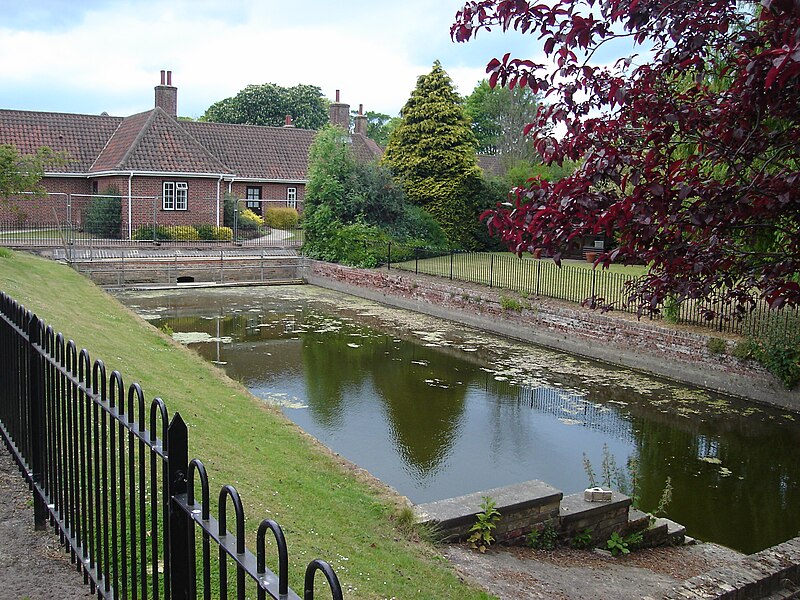Not sure if this fits in here on this forum because it is not a derelict or abandoned site but well-looked after, and Grade II listed. It is, however, not seen by many. Not because it is inaccessable or hidden away but rather because not many people know about it. It is unique, in that it is the only such structure left in the whole of the UK. And it is old.
"It" is the old swan pit in Norwich.

The swan pit is located on the grounds of the Great Hospital in Bishopsgate and accessible from there. The hospital is currently an old peoples' care home and parts of the complex are over 700 years old.

In medieval times swans were reserved for the table of the king and a handful of privileged nobles and clerics. Two creeks extended into the Great Hospital's precinct from the south bank of the River Wensum. At least one of them was navigable and small boats were able to travel within yards of the buildings in order to unload food, fuel and building supplies. One of the creeks fed fish ponds and both attracted many swans which in Stuart times continued to be protected.
The Great Hospital's cygnets were kept in a purpose-built confined area, the swan pit. It was constructed in 1793 by William Ivory, especially for containing the hospitals cygnets, to be fattened on grain and sold. One of them was sent to Sandringham every year, as a gift to the king. The pit was in use until WWII when it was forced to close due to the grain shortage. By this time the hospital had been supplying oven-ready swans for the tables of the rich all over the country. The birds were dispatched by rail, travelling in wicker baskets.


The pit is adjoined in the north by a stone sided channel with two 19th century sluice gates that link it with the River Wensum. The sluices ensure that the pit is filled at high tide, and unable to empty at low tide.

The picture above was taken from the Riverside Walk. A short distance further on a much older structure can be found - the Cow Tower, a military tower and one of the earliest purpose-built artillery blockhouses in England.

The Cow Tower was built in about 1399 to command a strategic point in Norwich’s city defence. It is situated beside the River Wensum in an area called Bishopsgate. The name Cow Tower comes from the water meadow it stands in which used to be known as Cowholme.
The gate is padlocked but allows a good view of the interior, which is empty, apart from pigeons.



Beside it, high up on a horse chestnut tree, there is another noteworthy structure - a luxury apartment block for birds and (possibly) bats. Not old but interesting nevertheless.

"It" is the old swan pit in Norwich.

The swan pit is located on the grounds of the Great Hospital in Bishopsgate and accessible from there. The hospital is currently an old peoples' care home and parts of the complex are over 700 years old.

In medieval times swans were reserved for the table of the king and a handful of privileged nobles and clerics. Two creeks extended into the Great Hospital's precinct from the south bank of the River Wensum. At least one of them was navigable and small boats were able to travel within yards of the buildings in order to unload food, fuel and building supplies. One of the creeks fed fish ponds and both attracted many swans which in Stuart times continued to be protected.
The Great Hospital's cygnets were kept in a purpose-built confined area, the swan pit. It was constructed in 1793 by William Ivory, especially for containing the hospitals cygnets, to be fattened on grain and sold. One of them was sent to Sandringham every year, as a gift to the king. The pit was in use until WWII when it was forced to close due to the grain shortage. By this time the hospital had been supplying oven-ready swans for the tables of the rich all over the country. The birds were dispatched by rail, travelling in wicker baskets.


The pit is adjoined in the north by a stone sided channel with two 19th century sluice gates that link it with the River Wensum. The sluices ensure that the pit is filled at high tide, and unable to empty at low tide.

The picture above was taken from the Riverside Walk. A short distance further on a much older structure can be found - the Cow Tower, a military tower and one of the earliest purpose-built artillery blockhouses in England.

The Cow Tower was built in about 1399 to command a strategic point in Norwich’s city defence. It is situated beside the River Wensum in an area called Bishopsgate. The name Cow Tower comes from the water meadow it stands in which used to be known as Cowholme.
The gate is padlocked but allows a good view of the interior, which is empty, apart from pigeons.



Beside it, high up on a horse chestnut tree, there is another noteworthy structure - a luxury apartment block for birds and (possibly) bats. Not old but interesting nevertheless.



































